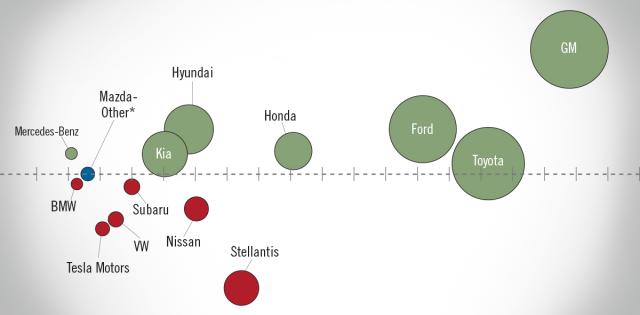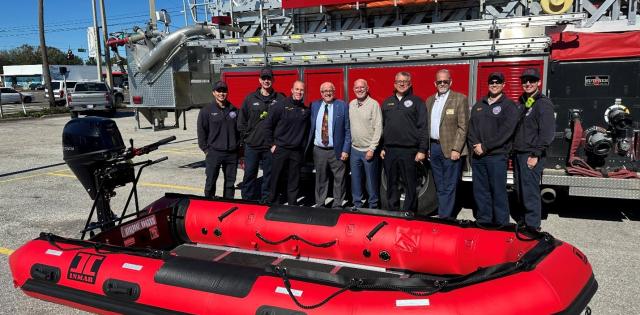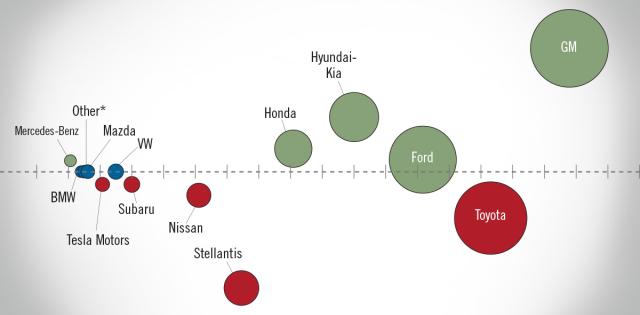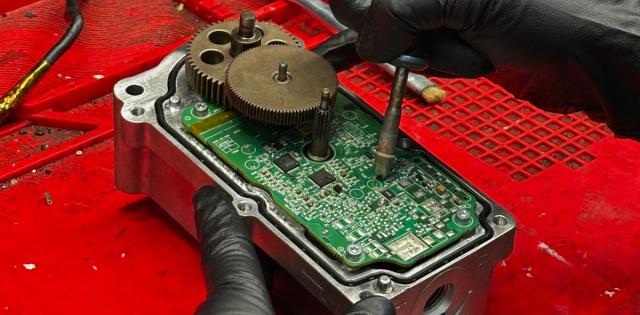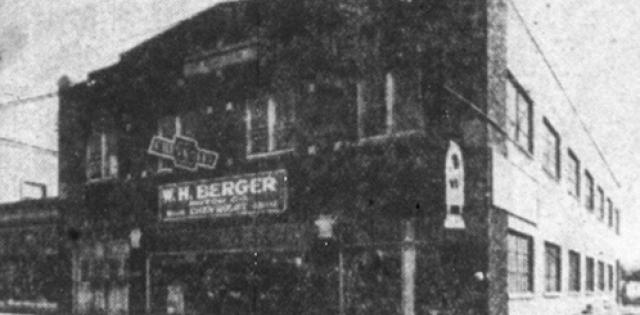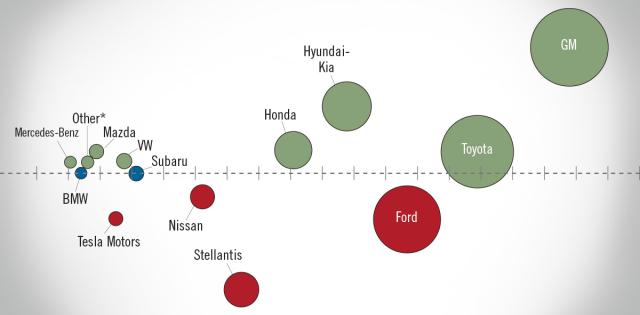Did you realize that there are actually two kinds of SEO? When most people talk about SEO, they're talking about “traditional” SEO, where you're doing things to a website to get it to show up at a higher ranking when someone does a search in Google. With local SEO, you're only working to get a website to show up in search for a specific geographic area.
Pizza delivery is the perfect example. If you go to Google and type in “pizza delivery”, you'll get a list of pizza delivery places near the dealership. If you go home and do the same search, you'll get a completely different set of results. Google knows your location (because of your IP address) and knows you need a pizza delivery joint that's nearby.
Google treats auto dealers the same way. Even if a city isn't entered as part of a search query, Google will return local results for automotive-related searches.
That's why it's important that dealers utilize a local SEO strategy. Local SEO involves additional signals and elements that aren't a part of traditional SEO.
If you're in a metro area, think about how many dealers are in your market. For the more general terms, you're fighting against every franchise dealer AND every used car dealer. There could be more than 200 dealerships in your metro area, and they're all fighting for a spot on page one of a buyer’s search results.
Without the extra signals involved with local SEO, you're not going to be able to compete. Take a look at the 2015 Local Search Ranking Factor Study from Moz. It's a detailed list of exactly which signals matter the most for local relevancy in Google searches.
Local SEO is the secret sauce that will help your dealership excel.
So what do you need to do to get your local SEO on track?
Below, you will find actionable steps you can take to improve your dealership’s local SEO rankings.

Optimizing on-site signals
The content on your website is the most important signal of local relevancy. You’ve got to have unique content that’s relevant and answers the questions your customers might have. Think about what makes your dealership unique. Think about the common questions you hear from your customers.
Read your content out loud – if it doesn’t sound like something you’d say to a customer over the phone, then you need to rewrite it.
Once you’ve got great content, make sure you’re including the right Local signals by including your city and state abbreviation in the following locations on each page:
- Title tag – the most important SEO element of any page. Never put your dealership at the beginning – you don’t need to optimize for the name of your dealership.
- H1 heading – the headline at the top of each page is also incredibly powerful. Make sure it’s conversational and isn’t the same text as the button that leads to that page.
- Page content – obviously, you need location information in the actual page text.
- Image alt text – since Google can’t interpret what’s in your images, alt text lets you describe what’s in each photo. It’s a great spot to include additional location information.
- URL – If you’re able to set custom URLs for the pages on your site, try to include location information whenever possible.
- Meta description – while it doesn’t count in the ranking algorithm, it shows as the link description whenever you show up as a search result in Google, so location information can help increase click through rate.
Local phone numbers are vital
Google uses local area codes as additional proof that a business is located in a particular area. With Local search, Google expects that local businesses will have phone numbers with a local area code.
Auto dealers love to use call tracking numbers, which are typically toll free – and these send a negative signal to Google. In most cases, dealers don’t really look at their call tracking reports, so the numbers aren’t really necessary. What’s more important to you – getting lots of information about the calls you already receive, or getting more phone calls because you’re ranking better?
It’s not impossible to rank well with a toll-free number, it’s just much harder. Some OEMs require that dealers use toll free tracking numbers so, if you’re in a similar situation, be sure to also include your local number on the page so it’s still visible to Google.
Optimizing off-site signals - Links
Inbound links (other sites linking to your dealership’s site) are the second most important signal of relevancy to Google. Unfortunately, links are no longer simply a numbers game – the links have to be relevant to your dealership.
Most traditional SEO providers will only target links from sites with a lot of authority, since those links tend to carry more weight. With Local SEO, it’s important to try to acquire links from low authority sites – as long as they’re local businesses. Even if the site doesn’t have much authority, a hyper-local website like a church site or a little league site carry a huge amount of relevancy for local.
When you’re building links to your dealership’s website, remember to point your links to multiple pages. Most dealerships only point links to their home page or inventory page, but you should actually try to build links to every important page on your site.
Think about the relationships you’ve built in your community, along with the things your dealership already does in the area. Mine these relationships for links – you’ll find that it’s incredibly easy to get local links if your dealership already has a relationship in place.
Optimizing off-site signals – Citations
Citations are mentions of your dealership’s name, address, and phone number on other websites. Dealers typically think of citations as directory sites, but citations can be free-form blog posts or news stories as well.
It’s incredibly important that your citation information is consistent everywhere it appears online. Your dealership name, address, and phone number should match character for character. If you’ve got incomplete, inconsistent, or duplicate citation information out in the ecosystem, you’re sending a bad signal to Google.
Use the Moz Local tool to do a quick check of your dealership’s top 15 citation sources. Enter your dealership’s name and zip code and check the resulting list of possible matches. If you don’t have any citation problems, you’ll only see one listing. If you see several listings that include different information, you know you’ve got some problems to address.
Once you click on one of the listings, the tool will display a list of the top 15 citation sites and how complete your citation information is on each site. If you click on any of the bars, you’ll jump directly to your listing on that particular site.
Once you’ve updated your information on the 15 most important sites, you can get more advanced and check every citation that exists using the Whitespark Local Citation Finder. The tool will locate every citation that exists for your dealership, and it’s an invaluable tool for citation work if you’ve got call tracking numbers to cleanup.
Optimizing review signals
Reviews are also an important part of Local search. You should concentrate on Google reviews – they’re the first thing that customers will see, and they’ll also pay in the ranking algorithm.
You need 5 reviews to see an aggregate score, and you should get at least 10 reviews before you try to get reviews anywhere else (there’s a slight rankings bump at 10 reviews). Ultimately, you should get more reviews than any of your competitors – but not too many more. If you have hundreds more reviews than your competitors, it looks fake and customers won’t trust the reviews.
It’s important that you make it easy for customers to leave reviews, and you should ask every customer for a review. Don’t try to get reviews on Yelp unless you know a customer uses Yelp often – Yelp will filter out reviews from non-users. It’s important to monitor the review sites every day, so you can catch reviews as soon as they happen.
It’s important to leave timely replies, especially to negative reviews. Make sure your replies are well-written and sincere.
Stay up to date on Google updates
Whenever Google rolls out an update to its algorithm, you should update your SEO tactics. Keep an eye on Search Engine Land, the web’s premier source of information and news about SEO, PPC, and online marketing – it’s got an excellent Local SEO section as well.
If you’re handling SEO internally at your dealership, it’s important to send your SEO staff to at least one or two SEO conferences every year. There are wide variety of conferences across the country to choose from – as long as it’s a conference that’s dedicated to several days of SEO training, it will be worth attending.
Greg presented the workshop “Automotive SEO is Serious Business” at the 2016 NADA Convention and Expo. View and download the handout from this still-timely presentation: Automotive SEO is Serious Business.
Note: This post has been updated from its original version, published 03/01/16. The views and opinions presented in this educational program and any accompanying handout material are those of the speakers, and do not necessarily represent the views or opinions of NADA. The speakers are not NADA representatives, and their presence on the program is not a NADA endorsement or sponsorship of the speaker or the speaker’s company, product, or services.
Nothing that is presented here is intended as legal advice, and this workshop program may not address all federal, state, or local regulatory or other legal issues raised by the subject matter it addresses. The purpose of the program is to help dealers improve the effectiveness of their business practices. The information presented is also not intended to urge or suggest that dealers adopt any specific practices or policies for their dealerships, nor is it intended to encourage concerted action among competitors or any other action on the part of dealers that would in any manner fix or stabilize the price or any element of the price of any good or service.


